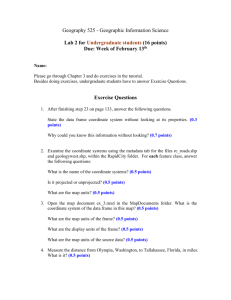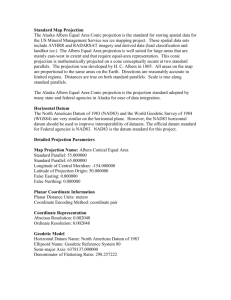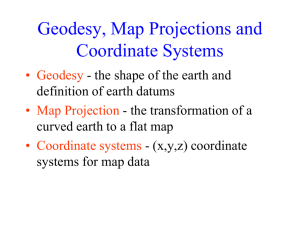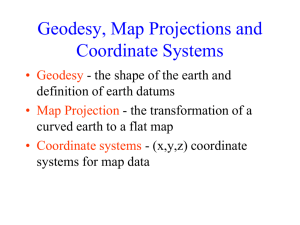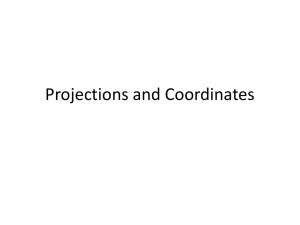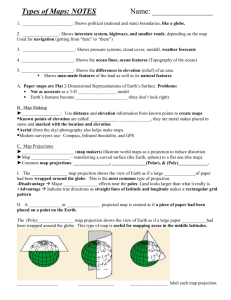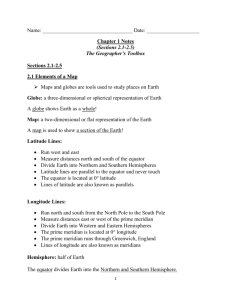Map Projection - School of Natural Resources
advertisement
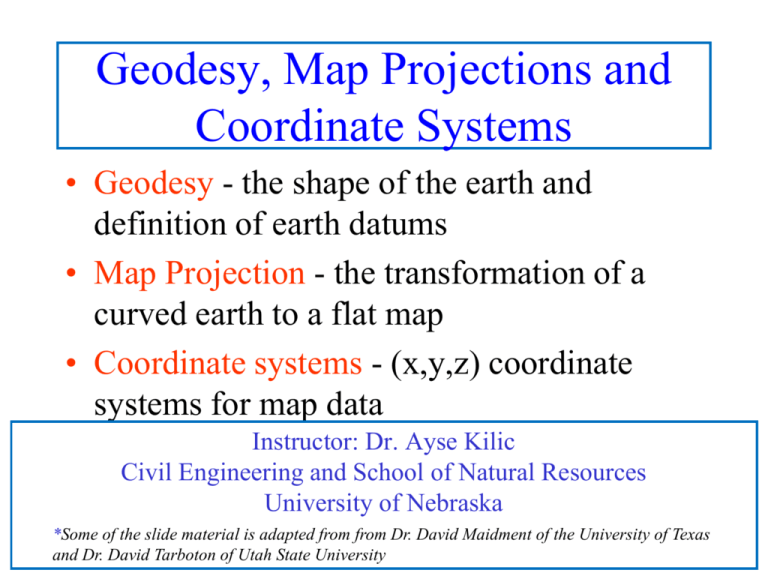
Geodesy, Map Projections and
Coordinate Systems
• Geodesy - the shape of the earth and
definition of earth datums
• Map Projection - the transformation of a
curved earth to a flat map
• Coordinate systems - (x,y,z) coordinate
systems for map data
Instructor: Dr. Ayse Kilic
Civil Engineering and School of Natural Resources
University of Nebraska
*Some of the slide material is adapted from from Dr. David Maidment of the University of Texas
and Dr. David Tarboton of Utah State University
Learning Objectives:
By the end of this class you should be able to:
•
•
•
•
•
Describe the role of geodesy as a basis for earth datums
List the basic types of map projection
Identify the properties of common map projections
Properly use the terminology of common coordinate systems
Use spatial references in arcmap so that geographic data are
properly displayed
– Determine the spatial reference system associated with a feature class or
data frame
– Use arcgis to convert between coordinate systems
• Calculate distances on a spherical earth and in a projected
coordinate system
Memorial Stadium
40° 49’ 14.25” N
96° 42’ 20.34”W
Z 47
E 306516.77
N 4521566.08
NE S
E 2773253.915
N 432764.266
Focusing on the “N” in the center of memorial stadium,
here are a bunch of numbers.
Survey question: What are these numbers?
3
Memorial Stadium
40° 49’ 14.25” N
96° 42’ 20.34”W
Global Coordinate
System
(Latitude/Longitude)
Z 47
E 306516.77
N 4521566.08
Universal
Transverse
Mercator (UTM)
NE S
E 2773253.915
N 432764.266
State Plane
Coordinate
System (SPCS)
Nebraska South
4
They all point to the same place, but they have different references
We’re going to talk about what those numbers mean and what
they do for us
Readings: Introduction
http://resources.arcgis.com/en/help/getting-started/articles/026n0000000s000000.htm
Readings: Further Detail
http://resources.arcgis.com/en/help/main/10.2/index.html#//003r00000001000000
History on maps
• Medieval Maps
Ancient “Globe”
Sun and stars rotating about “Island Earth”
Ptolemaic world 150 AD
(1493 depiction)
The oldest known maps
are preserved on
Babylonian Clay Tablets
from about 600 B.C.
Greek world view 300 BC
150 BC – Hipparchus of Rhodes
invented the concept of Lat/Long
Mercator’s Map-1569 AD
• Cylindrical projection – putti
a round globe onto a piece of
paper with meaningful accura
7
Revolution in Earth Measurement
Some images and slides from Michael Dennis, National Geodetic Survey and Lewis Lapine, South Carolina
Geodetic Survey
•
•
•
•
•
•
Traditional surveying is at least
3000 years old
Used by the ancient Egyptians to
mark out fields after the annual
Nile floods
Refined by the ancient Greek
and Romans
Today our knowledge of shape
of the earth is very advanced
Uses benchmarks as reference
points
These benchmarks actually tie
down the coordinates.
Global Positioning uses
fixed GPS receivers as
reference points
(Continuously
Operating Reference
System, CORS)
HOW ACCURATE CAN WE
KNOW A LOCATION? (and is it
static?)
If we really want to know the location very accurately, we
have to appreciate every point on the earth is moving because
of tectonic plates.
This has to take Tectonic Motions into account
Tectonic Motions
From Sella et al.,
2002
When tectonic plates move, our
benchmark locations change
30mm/yr equals 3 meters in 100
years
HORIZONTAL TECTONIC MOTIONS
Motion in cm/year
North American Plate
Pacific Plate
When is California not in North America …
…. when its on the Pacific Plate!
This leads to adjustments in locations of
the national network of survey
benchmarks
Survey Benchmark
{Latitude (f), Longitude (l), Elevation (z)}
Types of Coordinate Systems
• (1) Global Cartesian coordinates (x,y,z) for
the whole earth
• (2) Geographic coordinates Latitude (f),
Longitude (l), Elevation (z)
• (3) Projected coordinates (x, y, z) on a local
area of the earth’s surface
• The z-coordinate in (1) and (3) is defined
geometrically; in (2) the z-coordinate is
defined gravitationally
1. Global Cartesian Coordinates
(x,y,z)
Z
Greenwich
Meridian
•
O
Y
X
Equator
Spatial Reference = Datum +
Projection +
Coordinate system
• For consistent analysis the spatial reference of data sets
should be the same.
• ArcGIS does projection on the fly so it can display data
with different spatial references properly if they are
properly specified. (but it is “safest” if all layers are in
the same projection)
– Earth datums define standard values of the ellipsoid and geoid
– Different datums use different estimates for the precise shape and
size of the Earth (reference ellipsoids).
• ArcGIS terminology
– Define projection. Specify the projection for some data without
changing the data.
– Project. Change the data from one projection to another.
2. Geographic Coordinates (f, l, z)
• Latitude (f) and Longitude (l) defined
using an ellipsoid, an ellipse rotated about
an axis
• Elevation (z) defined using geoid, a surface
of constant gravitational potential
• Earth datums define standard values of the
ellipsoid and geoid
GEOID
• Geoid is mean sea level at a
particular point and varies with
gravitational potential
• Geoid is where mean sea level
would be if there was an ocean at
that location
• Geoid elevation is usually below
the land surface
•
•
•
The geoid is the shape that the surface of the oceans would take under the influence of
Earth's gravitation and rotation alone, in the absence of other influences such as winds
and tides.
All points on the geoid have the same gravitational potential.
The force of gravity acts everywhere perpendicular to the geoid, meaning that plumb
lines point perpendicular and water levels parallel to the geoid.
Shape of the Earth
We think of the
earth as a sphere
It is actually a spheroid,
slightly larger in radius at
the equator than at the poles
The earth is not round!
Ellipse
An ellipse is defined by:
Focal length =
Distance (F1, P, F2) is
constant for all points
on ellipse
When = 0, ellipse = circle
Z
b
O
F1
For the earth:
Major axis, a = 6378 km
Minor axis, b = 6357 km
Flattening ratio, f = (a-b)/a
~ 1/300
P
a
X
F2
Ellipsoid or Spheroid
Rotate an ellipse around an axis
Z
b
a O a
An Ellipse is 2 dimensional
A Spheroid is 3 dimensional
Y
X
Rotational axis
The X, Y, and Z axes are at
90 degree angles to each
other
Standard Ellipsoids
Ellipsoid
Major
Minor
Flattening
axis, a (m) axis, b (m) ratio, f
Clarke
(1866)
6,378,206 6,356,584 1/294.98
GRS80
6,378,137 6,356,752 1/298.57
Ref: Snyder, Map Projections, A working manual, USGS
Professional Paper 1395, p.12
Geodetic Datums
• World Geodetic System (WGS) – is a global system for
defining latitude (f) and longitude (l) on earth and does not
change even with tectonic movement (military).Therefore,
latitude and longitude coordinates of a point in Lincoln will
change with time if Lincoln moves.
• North American Datum (NAD) – is a system defined for
locating fixed objects on the earth’s surface and includes
tectonic movement (civilian) (Everything is moving).
Therefore, latitude and longitude coordinates of a point in
Lincoln will not change with time if Lincoln moves.
• Lincoln (40.8106° N, 96.6803° W)
Horizontal Earth Datums
• An earth datum is defined by an ellipse and
an axis of rotation
• NAD27 (North American Datum of 1927)
uses the Clarke (1866) ellipsoid on a non
geocentric axis of rotation
• NAD83 (NAD,1983) uses the GRS80
ellipsoid on a geocentric axis of rotation
• WGS84 (World Geodetic System of 1984)
uses GRS80, almost the same as NAD83
Adjustments of the NAD83 Datum
Slightly different (f, l) for benchmark
Continuously Operating Reference System
Canadian Spatial Reference System
National Spatial Reference System
High Accuracy Reference Network
Representations of the Earth
Mean Sea Level is a surface of constant
gravitational potential called the Geoid
Sea surface
Ellipsoid
Earth surface
Geoid
THE GEOID AND TWO
ELLIPSOIDS
CLARKE 1866
(NAD27)
GRS80-WGS84
(NAD83)
Earth Mass
Center
Approximately
236 meters
GEOID
WGS 84 and NAD 83
International
Terrestrial
Reference Frame
(ITRF) includes
updates to WGS84 (~ 2 cm)
World Geodetic
System of 1984
(WGS 84) is
reference frame for
Global Positioning
Systems
North American
Datum of 1983
(NAD 83) (Civilian
Datum of US)
Earth Mass
Center
2.2 m (3-D)
dX,dY,dZ
GEOID
Latitude (f) & Longitude (l)
Strict definition of Latitude, f
m
O
q
f
S p
n
r
(1) Take a point S on the surface of the ellipsoid and define
there the tangent plane, mn
(2) Define the line pq through S and normal to the
tangent plane
(3) Angle pqr which this line makes with the equatorial
plane is the latitude f, of point S
Cutting Plane of a Meridian
P
Prime Meridian
Equator
Meridian
Definition of Longitude, l
l = the angle between a cutting plane on the prime meridian
and the cutting plane on the meridian through the point, P
-150°
180°E, W
150°
-120°
120°
90°W
(-90 °)
90°E
(+90 °)
P l
-60°
-30°
-60°
30°
0°E, W
Latitude and Longitude on a Sphere
Meridian of longitude
Z
Greenwich
meridian
l=0°
N
Parallel of latitude
P
•
W
•
•
X
O
l
Equator
R
=0°
•
E
l - Geographic longitude
- Geographic latitude
Y
R - Mean earth radius
O - Geocenter
Length on Meridians and Parallels
(Lat, Long) = (f, l)
Length on a Meridian:
AB = Re Df
(same for all latitudes)
R Dl
Re
Length on a Parallel:
CD = R Dl = Re Dl Cos f
(varies with latitude)
•Meridians converge as poles are approached
R
C
Df B
Re
A
D
Example: What is the length of a 1º increment along
on a meridian and on a parallel at 30N, 90W?
Radius of the earth = 6370 km.
Solution:
• A 1º angle has first to be converted to radians
2p radians = 360 º, so 1º = 2p/360 = 2*3.1416/360 = 0.0175
radians
• For the meridian, DL = Re Df = 6370 * 0.0175 = 111 km
• For the parallel, DL = Re Dl Cos f
= 6370 * 0.0175 * Cos 30
= 96.5 km
• Meridians converge as poles are approached
Curved Earth Distance
(from A to B)
Shortest distance is along a “Great
Circle”
Z
A “Great Circle” is the intersection of
a sphere with a plane going through
its center.
B
A
1. Spherical coordinates converted
to Cartesian coordinates.
2. Vector dot product used to
calculate angle from latitude and
longitude
3. Great circle distance is R,
where R=6378.137 km2
•
Y
X
Dist = R cos 1[sin f A sin fB cos f A cos fB cos(lA lB )]
Ref: Meyer, T.H. (2010), Introduction to Geometrical and Physical Geodesy, ESRI Press, Redlands, p. 108
Definition of Elevation
Elevation Z
P
•
z = zp
z = 0 Land Surface
Mean Sea level = Geoid
Elevation is measured from the Geoid
Three systems for measuring elevation
What reference system (datum) is used?
Sea surface
Ellipsoid
Earth surface
Geoid
1.
2.
3.
Orthometric heights (land surveys, geoid)
Ellipsoidal heights (lidar, GPS)
Tidal heights (Sea water level)
Geoid is mean sea level at a particular point and varies with gravitational potential
Three systems for measuring
elevation
Orthometric heights
(land surveys, geoid)
Ellipsoidal heights
(lidar, GPS)
Tidal heights
(Sea water level)
Conversion among these height systems has some uncertainty
Trends in Tide Levels
(coastal flood risk is changing)
Charleston, SC
+ 1.08 ft/century
1900
2000
Galveston, TX
+ 2.13 ft/century
- 4.16 ft/century
1900
Juneau, AK
2000
1900
2000
Gravity Anomaly
Earth surface
Ocean
Geoid
Gravity Anomaly
Gravity anomaly is the elevation difference between
a standard shape of the earth (ellipsoid) and a surface
of constant gravitational potential (geoid)
Vertical Earth Datums
• A vertical datum defines elevation, z
• NGVD29 (National Geodetic Vertical
Datum of 1929)
• NAVD88 (North American Vertical Datum
of 1988)
• takes into account a map of gravity
anomalies between the ellipsoid and the
geoid
Converting Vertical Datums
• Corps program Corpscon (not in ArcInfo)
– http://crunch.tec.army.mil/software/corpscon/corpscon.html
Point file attributed with the
elevation difference between
NGVD 29 and NAVD 88
NGVD 29 terrain + adjustment
= NAVD 88 terrain elevation
Importance of geodetic datums
NAVD88 – NGVD29 (cm)
NGVD29 higher
in East
More than 1 meter difference
NAVD88 higher
in West
Orthometric datum height shifts are significant relative to BFE
accuracy, so standardization on NAVD88 is justified
Geodesy and Map Projections
• Geodesy - the shape of the earth and
definition of earth datums
• Map Projection - the transformation of a
curved earth to a flat map
• Coordinate systems - (x,y) coordinate
systems for map data
Earth to Globe to Map
To prepare a map, the earth is first reduced to a globe and then projected onto
a flat surface
Map Scale:
Representative Fraction
= Globe distance
Earth distance
(e.g. 1:24,000)
Map Projection:
Scale Factor
Map distance
=
Globe distance
(e.g. 0.9996)
Geographic and Projected Coordinates
(f, l)
Map Projection
(x, y)
Map projection is how we go from the ‘true’ global (spheroid) system to a ‘flat’ X-Y system.
There are many, many map projection systems.
How do we make Maps?
-- Types of Projections -• Conic (Albers Equal Area, Lambert
Conformal Conic) - good for East-West
land areas
• Cylindrical (Transverse Mercator) - good
for North-South land areas
• Azimuthal (Lambert Azimuthal Equal Area)
- good for global views
These projection techniques are how we create the ‘flat’ map from the globe
Projections Preserve Some
Earth Properties (but not all at once)
• Area - correct earth surface area (Albers
Equal Area) important for mass balances
• Shape - local angles are shown correctly
(Lambert Conformal Conic)
• Direction - all directions are shown correctly
relative to the center (Lambert Azimuthal
Equal Area)
• Distance - preserved along particular lines
• Some projections preserve two properties
Conic Projections
(Albers Equal Area, Lambert Conformal Conic)
In the Secant method, a Cone is
placed over the globe but cuts
through the surface.
The cone and globe meet along two
latitude lines. These are the standard
parallels.
The cone is cut along the line of
longitude that is opposite the central
meridian and flattened into a plane.
Conic Projections
A cone is placed over a globe. The cone and globe meet along a latitude line. This is the
standard parallel. This is where the accuracy is highest (perfect). In other latitudes, the
accuracy is less. The cone is cut along the line of longitude that is opposite the central
meridian and flattened into a plane.
A cone is placed over a globe but cuts through the surface. The cone and globe meet
along two latitude lines. These are the standard parallels. The cone is cut along the
line of longitude that is opposite the central meridian and flattened into a plane.
Cylindrical Projections
(Transverse Mercator)
Transverse
Oblique
Projecting the sphere onto a cylinder tangent
Cylindrical Projections
(Transverse Mercator)
Wherever the cylinder touches the globe, the highest the accuracy.
Other areas get some distortion.
Azimuthal (Lambert)
• A plane is placed over a globe. The plane can touch
the globe at the pole (polar case), the equator
(equatorial case), or another line (oblique case).
• All azimuthal projections preserve the azimuth
(angle) from a reference point
• Presenting true direction (but not
necessarily distance) to any other points.
• Also called planar since several of them are obtained
straightforwardly by direct perspective projection to
a plane surface.
Use this method if accuracy in
‘direction’ is more important
than accuracy in ‘distance.’
-- there are different styles of conic projections
Albers Equal Area Conic Projection
• Conic projection that
maintains accurate area
measurements.
• It differs from the Lambert
Conformal Conic projection in
preserving area rather than
shape and in representing
both poles as arcs rather than
one pole as a single point
• The meridians do not
converge at the poles
• Uses two standard parallels,
or secant lines
• Distances are most accurate in
the middle latitudes.
Lambert Conformal Conic Projection
• Portrays shape more accurately
than area
• The State Plane Coordinate
System uses this projection for
all zones that have a greater
east–west extent
• Represents the poles as a single
point
(more on UTM later)
Universal Transverse Mercator Projection
• Uses a 2-dimensional Cartesian coordinate
system to give locations on the surface of the
Earth
• It is a horizontal position representation
• Divides the Earth into sixty zones, each a sixdegree band of longitude, and uses a secant
• in each zone
• This projection is conformal, so it preserves
angles and approximates shape but distorts
distance and area
• Each of the 60 zones uses a TM projection
that can map a region of large north-south
extent with low distortion
UTM is a VERY important and
widely used Projection
Lambert Azimuthal Equal Area Projection
Web Mercator Projection
(used for ESRI Basemaps)
Web Mercator is one of the
most popular coordinate
systems used in web
applications because it fits the
entire globe into a square area
that can be covered by 256 by
256 pixel tiles.
The spatial reference for the
ArcGIS Online / Google
Maps / Bing Maps tiling
scheme is WGS 1984 Web
Mercator (Auxiliary
Sphere).
Web Mercator Projection is also used by Google Maps
Web Mercator
Parameters
(20037, 19971 km)
Distance from origin
= earth rad * π
Standard Parallel
(0,0)
6357 km
6378 km
Earth radius
Central Meridian
Projection and Datum
Two datasets can differ in both the
projection and the datum, so it is
important to know both for every
dataset.
Geodesy and Map Projections
• Geodesy - the shape of the earth and
definition of earth datums
• Map Projection - the transformation of a
curved earth to a flat map
• Coordinate systems - (x,y) coordinate
systems for map data
3. Coordinate Systems
• Universal Transverse Mercator (UTM) - a
global system developed by the US Military
Services
• State Plane Coordinate System - civilian
system for defining legal boundaries
3. Coordinate System
A planar coordinate system is defined by a pair
of orthogonal (x,y) axes drawn through an origin
Y
X
Origin
(xo,yo)
(fo,lo)
The origin can be wherever the user wishes. However, there are standard locations.
Universal Transverse
Mercator
• Uses the Transverse Mercator projection
• Each zone has a Central Meridian (lo),
zones are 6° wide, and go from pole to pole
• 60 zones cover the earth from East to West
• Reference Latitude (fo), is the equator
• (Xshift, Yshift) = (xo,yo) = (500000, 0) in
the Northern Hemisphere, units are meters
UTM Zone 14
-99°
-102° -96°
6°
Origin
-120°
Zone 14 runs through Nebraska.
-90 °
Equator
-60 °
State Plane Coordinate System
• Defined for each State in the United States
• East-West States (e.g. Texas) use Lambert
Conformal Conic, North-South States (e.g.
California) use Transverse Mercator
• Nebraska has one zone, and Texas has five
zones (North, North Central, Central, South
Central, South) to give accurate
representation
• Greatest accuracy for local measurements
ArcGIS Spatial Reference Frames
• Defined for a feature
dataset in ArcCatalog
• XY Coordinate System
– Projected
– Geographic
• Z Coordinate system
• Domain, resolution and
tolerance
Horizontal Coordinate Systems
• Geographic
coordinates (decimal
degrees)
• Projected coordinates
(length units, ft or
meters)
There are many, many coordinate systems available in Arc!
Vertical Coordinate Systems
• None for 2D
data
• Necessary for
3D data
ArcGIS .prj files
The ‘prj’ file is used by Arc to hold information on the specific projection
Summary Concepts
• The spatial reference of a dataset comprises
datum, projection and coordinate system.
• For consistent analysis the spatial reference of
data sets should be the same.
• ArcGIS does projection on the fly so can display
data with different spatial references properly if
they are properly specified (but it is best to project layers
to the same basis to check accuracy of overlapping).
• ArcGIS terminology
– Define projection. Specify the projection for some
data without changing the data.
– Project. Change the data from one projection to
another.
Summary Concepts (Cont.)
• Two basic locational systems: geometric or
Cartesian (x, y, z) and geographic or
gravitational (f, l, z)
• Mean sea level surface or geoid is
approximated by an ellipsoid to define an
earth datum which gives (f, l) and distance
above geoid gives (z)
Summary Concepts (Cont.)
• To prepare a map, the earth is first reduced
to a globe and then projected onto a flat
surface
• Three basic types of map projections: conic,
cylindrical and azimuthal
• A particular projection is defined by a
datum, a projection type and a set of
projection parameters
Summary Concepts (Cont.)
• Standard coordinate systems use particular
projections over zones of the earth’s surface
• Types of standard coordinate systems:
UTM, State Plane
• Web Mercator coordinate system (WGS84
datum) is standard for ArcGIS basemaps
Global Positioning Systems
(Press and hold)
Garmin GPSMAP 276C GPS Receiver
Trimble GeoXHTM
GPS Satellites
•
•
•
•
•
Satellite-based navigation system
originally developed for military
purposes (NAVSTAR1 -1978).
NAVSTAR Global Positioning
System (GPS)
Globally available since 1994
Maintained and controlled by the
United States Department of
Defense ( 50th Space Wing (50
SW))
There are two GPS systems:
NAVSTAR - United State's
system, and GLONASS - the
Russian version
GPS permits users to determine
their three-dimensional position,
velocity, and time.
Landsat
90 minute orbit
GLONASS
NAVSTAR
Constellation Arrangement
•
•
•
•
•
•
•
GPS satellites fly in Medium Earth orbit (MEO) at
an altitude of approximately 20,200 km (12,550
miles).
Each satellite circles the Earth twice a day. 12 hour
return interval for each satellite
GPS uses radio transmissions.
The satellites transmit timing information and
satellite location information.
The United States is committed to maintaining the
availability of at least 24 operational GPS
satellites, 95% of the time.
To ensure this commitment, the Air Force has been
flying 31 operational GPS satellites for the past
few years.
Satellites are distributed among six offset orbital
planes
How GPS works in five logical steps:
1.
2.
3.
4.
5.
The basis of GPS is triangulation from satellites
GPS receiver measures distance from satellite using
the travel time of radio signals
To measure travel time, GPS needs very accurate
timing
Along with distance, you need to know exactly
where the satellites are in space. Satellite location.
High orbits and careful monitoring are the secret
You must correct for any delays the signal
experiences as it travels through the atmosphere
Distance from satellite
• Radio waves = speed of
light
– Receivers have nanosecond
accuracy (0.000000001
second)
• All satellites transmit same
signal “string” at same time
– Difference in time from
satellite to time received
gives distance from satellite
Speed of light - -approximate values
kilometres per second
300,000
kilometres per hour
1,080
million
miles per second
186,000
miles per hour
671 million
Triangulation
Triangulation
Differential GPS
• Differential GPS uses the time
sequence of observed errors at
fixed locations to adjust
simultaneous measurements at
mobile receivers
• A location measurement
accurate to 1 cm horizontally
and 2cm vertically is now
possible in 3 minutes with a
mobile receiver
• More accurate measurements
if the instrument is left in place
longer
